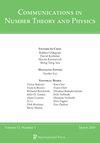费曼振幅,相互作用原理,和宇宙伽罗瓦群
IF 1.2
3区 数学
Q1 MATHEMATICS
引用次数: 72
摘要
这是2015年5月在IHES上关于费曼振幅和动力周期的讲座的第一部分。0.1. 一些物理学家的动机。散射振幅在高能物理中无处不在,并且已经从至少三个角度进行了深入研究:(1)在现象学中,量子场论中的振幅是作为与表示基本粒子之间相互作用的图相关的费曼积分的总和获得的。这对对撞机实验的重要应用提出了巨大的计算挑战。(2)在超弦微扰理论中,振幅表示为带标记点曲线模空间上的积分。(3)在各种现代方法中,最明显的是在N = 4 SYM的平面极限中,它们完全避免使用费曼图,并寻求通过自举法或通过壳图或振幅面体等几何方法直接构造振幅。这些笔记的目的是研究一种新的结构,这种结构在所有三种情况下都可能被振幅所满足。为了激发它,首先考虑二重函数的情况,它由和定义为|z| < 1本文章由计算机程序翻译,如有差异,请以英文原文为准。
Feynman amplitudes, coaction principle, and cosmic Galois group
The first part of a set of notes based on lectures given at the IHES in May 2015 on Feynman amplitudes and motivic periods. 0.1. Some motivation for physicists. Scattering amplitudes are ubiquitous in high energy physics and have been intensively studied from at least three angles: (1) in phenomenology, where amplitudes in quantum field theory are obtained as a sum of Feynman integrals associated to graphs which represent interactions between fundamental particles. This presents a huge computational challenge with important applications to collider experiments. (2) in superstring perturbation theory, where amplitudes are expressed as integrals over moduli spaces of curves with marked points. (3) in various modern approaches, most notably in the planar limit of N = 4 SYM, which avoid the use of Feynman graphs altogether and seek to construct the amplitude directly, either via the bootstrap method, or via geometric approaches such as on-shell diagrams or the amplituhedron. The goal of these notes is to study a new kind of structure which is potentially satisfied by amplitudes in all three situations. To motivate it, consider first the case of the dilogarithm function, defined for |z| < 1 by the sum
求助全文
通过发布文献求助,成功后即可免费获取论文全文。
去求助
来源期刊

Communications in Number Theory and Physics
MATHEMATICS, APPLIED-MATHEMATICS
CiteScore
2.70
自引率
5.30%
发文量
8
审稿时长
>12 weeks
期刊介绍:
Focused on the applications of number theory in the broadest sense to theoretical physics. Offers a forum for communication among researchers in number theory and theoretical physics by publishing primarily research, review, and expository articles regarding the relationship and dynamics between the two fields.
 求助内容:
求助内容: 应助结果提醒方式:
应助结果提醒方式:


